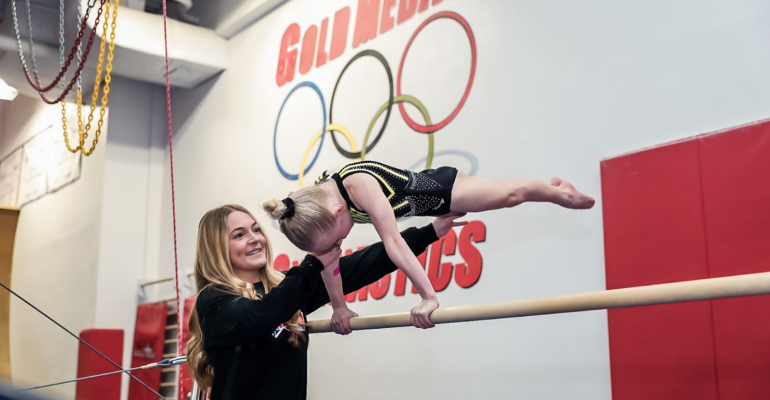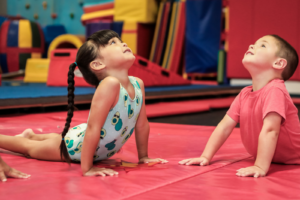Do you remember the first time you saw a high-level gymnast effortlessly complete a routine? For many young aspiring gymnasts and their parents, Level 1 gymnastics serves as the first step toward achieving that captivating display. At this stage, children typically aged 7 to 12, are introduced to the fundamental skills that will lay the groundwork for more advanced maneuvers.
Is your child ready to embark on a gymnastics journey, beginning with the basics of Level 1?
On This Page
Key Takeaways
- Understand the structure and basic requirements of Level 1 gymnastics
- Learn the core skills taught at this introductory level
- Discover how to progress within Level 1 and beyond
- Get insights on finding the right gymnastics program and communicating with coaches
- Learn how to prepare your child for their first gymnastics class
Understanding Level 1 Gymnastics
Enrolling your child in a gymnastics program can be a transformative experience, offering them the opportunity to develop not only physical strength but also discipline and confidence. Level 1 gymnastics serves as an essential introduction to the sport, focusing on basic skills that form the building blocks for more complex movements.
Overview of Gymnastics Levels
Gymnastics levels are designed by the USAG to ensure that young athletes develop their skills progressively and safely. At Level 1, gymnasts are introduced to the basics of the sport, establishing a strong foundation in strength, flexibility, and coordination. This initial stage is crucial, as the techniques learned here will be refined and built upon as the gymnast advances through subsequent levels.
Each level in gymnastics is structured to build on the previous one, making a clear understanding of progression important for parents and beginners. Introducing children to this structured environment helps them grasp the essence of the sport and sets realistic expectations. By focusing on basic skills first, gymnasts develop the necessary physical attributes that will enable them to handle more complex routines and requirements as they climb the ladder of competition levels.
5 Basic Skills in Level 1 Gymnastics
Level 1 gymnastics primarily emphasizes the development of core skills that are essential for any gymnast. These skills not only create the physical foundation needed for advanced moves but also instill the discipline and focus that define successful athletes. Below are some of the fundamental skills taught at this level.
1. Forward Rolls
The forward roll is one of the quintessential skills introduced early in Level 1 gymnastics. It appears simple, yet it plays a significant role in teaching young gymnasts balance and body control. During a forward roll, children learn how to transition their weight smoothly from their feet to their hands and then over their heads, ending back on their feet. This move helps develop a gymnast’s spatial awareness, ensuring they understand where their body is in space at all times.
Executing a forward roll also involves crucial elements such as tucking the chin and rounding the back, which help protect the neck and spine. Practicing this skill repeatedly aids in building the muscles required for more complex maneuvers, and it serves as a fundamental building block for other tumbling movements. It’s an essential skill that lays the groundwork for more elaborate routines and sequences.
2. Cartwheels
Moving from forward rolls, gymnasts are introduced to cartwheels, a skill that brings a new dimension of movement to the table. Cartwheels teach gymnasts lateral movement and coordination, both of which are crucial for higher-level gymnastics. This skill requires the athlete to move sideways, shifting their weight from one hand to the other while maintaining a linear form.
Cartwheels also focus on building upper body strength and flexibility. The repeated motion strengthens the arms and shoulders, preparing the gymnast for more advanced skills like handstands and walkovers. More than just a transitional move, the cartwheel incorporates elements of balance, timing, and precise movement, helping gymnasts develop a keen sense of body mechanics.
3. Handstands
A cornerstone of gymnastics, the handstand is a skill that underpins many advanced maneuvers. At Level 1, gymnasts begin by practicing handstands against a wall or with a spotter to develop the necessary upper body strength and balance. This exercise dramatically improves a gymnast’s understanding of weight distribution, which is key when performing any skill that requires inverted positions.
Handstands serve as a foundation for numerous other movements, including walkovers and handsprings. Mastering this skill instills a sense of confidence, as gymnasts learn to trust their own bodies in an upside-down position. It’s a critical skill that paves the way for successful progression in gymnastics.
4. Jumps and Leaps
In gymnastics, jumps and leaps aren’t just about aesthetics; they are about building lower body strength, agility, and cardiovascular endurance. Skills such as the tuck jump or split leap are introduced at Level 1, focusing on height and form. These moves help gymnasts gain the explosive power needed for vaults and other high-energy skills.
Practicing jumps and leaps also enhances a gymnast’s fluidity and grace, contributing significantly to the overall quality of their routines. Both elements are vital for executing routines that are not only technically sound but also visually captivating. This level of finesse becomes increasingly important as they move to higher levels of gymnastics.
5. Stretching and Flexibility
Stretching and flexibility play a pivotal role in any gymnast’s training regimen. Incorporating regular stretching enhances a gymnast’s overall flexibility and range of motion, which are crucial for executing complex moves safely and effectively. Stretching not only prepares the muscles for the physical demands of gymnastics but also helps prevent injuries.
Coaches emphasize stretching in every practice session, focusing on specific muscle groups that are heavily used in gymnastics. Consistent stretching is essential for long-term progress, allowing gymnasts to increase their flexibility gradually and safely. Activities like the stretch jump and relevé lock stand incorporate these elements, ensuring that flexibility isn’t just an added bonus but a core part of the training routine.
Progression in Level 1 Gymnastics
Progressing in Level 1 gymnastics isn’t just about learning more skills; it’s about refining and perfecting the fundamentals. This progression ensures a well-rounded development that prepares gymnasts for higher levels.
Building Upon Fundamental Skills
Fundamental skills create a robust base for future gymnastics success. Coaches continuously assess each gymnast’s progress, fine-tuning techniques to ensure that every movement is executed correctly. This meticulous attention to detail ensures that small errors are corrected early, preventing them from becoming ingrained habits.
Celebrating small milestones is also essential. Achievements, no matter how minor, keep gymnasts motivated and engaged. Whether it’s finally nailing that perfect handstand or mastering a forward roll, each success builds the confidence and enthusiasm needed to tackle more complex tasks.
Getting Started with Level 1 Gymnastics
Starting a journey in gymnastics is exciting and daunting, especially for parents and their young athletes. Knowing what to look for and how to prepare can make this transition smoother and more enjoyable.
Finding a Gymnastics Program
Finding the right gymnastics program is the first step in your child’s gymnastics journey. For aspiring or current level 1 gymnasts, check out GMGC’s Super Silvers classes.
Learn more about Gold Medal Gymnastics Centers and our 6 Long Island Locations, plus our new Short Hills, NJ Location opening Fall 2024! Sign Up today at GMGC.com or call your nearest location!
Conclusion
Level 1 gymnastics is more than just an introduction to the sport; it’s a vital foundation that shapes a gymnast’s future success. Understanding the skills and requirements at this level helps parents and young athletes set realistic expectations and goals. From mastering basic skills like forward rolls and cartwheels to building strength and flexibility, Level 1 sets the stage for an exciting and rewarding gymnastics journey.
Are you ready to see your child flourish in their gymnastics journey? Let’s embark on this exciting path together, building strong, confident athletes one skill at a time. Sign up now at GMGC.com
Frequently Asked Questions
What is gymnastics level 1?
Gymnastics Level 1 is the beginner level where athletes learn basic skills such as forward rolls, backward rolls, cartwheels, and handstands. It is the foundation for higher levels in gymnastics.
What is level 2 gymnastics?
Level 2 gymnastics builds upon the skills learned in Level 1 and introduces more complex movements like back walkovers, front handsprings, and round-offs. Athletes continue to refine their technique and form at this level.
What level was Simone Biles at age 11?
At age 11, Simone Biles was competing at Level 5 in gymnastics. She quickly progressed through the levels and went on to become one of the most accomplished gymnasts in history.
What level is Simone Biles?
Simone Biles is currently competing at the elite level in gymnastics. She has reached the highest level in the sport and has won multiple Olympic and World Championship titles.



